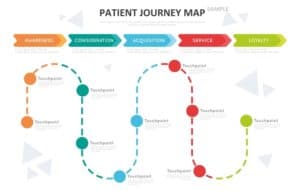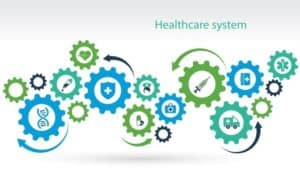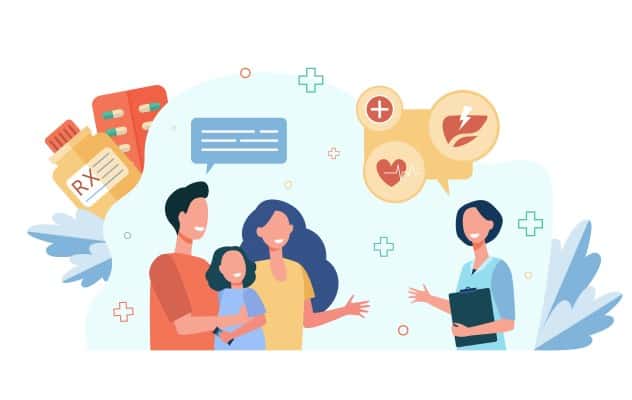I had to reschedule a dentist’s appointment the other day, which I set up via WhatsApp. So I sent them a message asking to reschedule my visit for a different date. They responded with, “This day is fully booked.” I offered yet another date and received the same response. Finally, after a few iterations, sincerely puzzled, I asked why I was the one suggesting dates.
That’s how my dentist’s office discovered a slight inefficiency in their patient journey mapping, and I got a discount for tooth filling. If you want to learn how to do patient journey mapping right so you don’t have to throw discounts around, keep reading.
Table of Contents:
- What is a Patient Journey Map?
- Benefits of Patient Journey Mapping
- How Can Hospitals Increase Patient Flow With The Patient Journey Map?
- What Types of Journey Maps Exist?
- What Does Journey Map Consist of?
- How to Create a Patient Journey Map: Step-by-Step
What is a Patient Journey Map?
In the healthcare software development realm, a journey map is nothing new. App developers use customer journeys all the time to better understand how people interact with digital products they are building. In this capacity, a journey map visually captures all customer experiences as they engage with a product or service, start to finish.

Patient journey definition
“OK, but how does that apply to healthcare and more specifically to patient journey maps?” you may ask. When we talk about patient journey mapping, what’s implied is a visual representation of all patient interactions with a healthcare system.
It’s not some abstract notion or a newly minted buzzword thrown around at healthcare conferences. On the contrary, a patient journey map is a very practical thing that helps care providers better understand their customers and drive efficiencies when serving them.
A practical patient journey map meticulously covers prolonged, multi-channel, and multi-platform user experiences taking place when customers seek to achieve their personal health goals with a particular healthcare provider.
A few other terms closely related to the patient care journey include touchpoint, interaction, and patient persona.
Patient interactions
Interaction is any engagement, virtual or face-to-face, between patients and healthcare systems. Things like visiting a doctor, getting a text reminder about an appointment, or researching a clinic’s services — all these and many other activities go by the name of patient interactions.
It’s worth noting that a patient journey map doesn’t start and end with the most apparent interactions like diagnosis or treatment. It naturally includes all steps leading to and following treatment. Therefore, patients discovering and researching their symptoms are also part of patient journey mapping, much like post-treatment follow-ups and medication adherence.

Touchpoints
Touchpoints are where interactions occur: interfaces, front desk, patient portals, and other contact points. You can say there are active and passive patient journey touchpoints throughout the patient journey through hospital.
For example, when a customer engages in a conversation with a chatbot on a clinic’s site, it’s an active touchpoint. However, when doctors update patient records in an EHR, we deal with a passive touchpoint.
Patient persona
Finally, there’s a patient persona concept. There are different patients out there, with varying pain points, demographics, etc. And it’s no wonder they will have different experiences while dealing with the same healthcare provider.
Benefits of Patient Journey Mapping
Patient healthcare journeys emerged as a result of the consumerization of healthcare. Thank you, modern medicine, for starting to treat patients as customers consuming healthcare services and products. Eventually, this patient-centric approach can dramatically impact how healthcare services are provided and administered, leading to better outcomes for patients.
What advantages can healthcare systems expect after implementing care journey maps?
Assess effectiveness
Whenever a patient feels frustrated or confused about her next steps on the path to healing, it’s a clear indication of friction points or blank spaces in healthcare processes.
A decent patient journey map helps uncover such inefficiencies and find ways to improve workflows by aligning them with patient expectations. Even though it may look like they are giving up the control, by placing patient experiences front and center, healthcare companies benefit from co-creating effective customer-driven journey maps.

Find commonalities and opportunities
After uncovering all potential choke points in the care journey, providers may start looking at how they can turn them into new opportunities to better serve their customers. Most of the time, improving the patient journey involves optimizing existing and introducing new digital solutions.
- Does it make sense to introduce a new channel, e.g., a chatbot?
- Will patients benefit if we make our services available on mobile platforms?
- How can we enhance this touchpoint to smooth out the transition to the next stage of the journey?
Healthcare providers will need to figure out answers to these and other similar questions to drive real value from a patient journey map.
Begin solving for a persona
Finally, a well-designed patient journey map helps healthcare companies organize their services around distinct patient personas instead of a one-size-fits-all approach. This, in turn, leads to building stronger relationships with patients and results in improved continuous care.
How Can Hospitals Increase Patient Flow With The Patient Journey Map?
As we’ve already discussed, hospital patient journey mapping helps healthcare systems uncover inefficiencies and turn them into opportunities. By removing the choke points, hospitals can smoothen the transition between stages for patients, increasing patient flow overall.
Care journey maps help remove silos inside a healthcare organization, ensuring that medical personnel remains focused on the customer throughout their patient journey in the hospital. This is achieved by streamlining internal workflows and interconnecting various touchpoints on a single platform that encompasses all patient interactions.
What Types of Journey Maps Exist?
Let’s look at the different types of patient journey maps that exist out there and decide which one fits your organization best.
Patient-centric vs. provider-centric journey maps
Oftentimes, patient journey maps are created from the healthcare system’s perspective. They are sort of inside-out by nature, not necessarily reflecting how patients perceive this process. That’s why most of the time, such flawed journey maps reflect who patients interact with and what tools are used by healthcare providers instead of focusing on actual patient needs, emotions, and expectations.

In contrast to such a provider-focused approach, modern patient-centric journey maps strive to capture patient experiences, their specific conditions, and context while dealing with a healthcare organization.
Qualitative vs. quantitative patient journey maps
Another way of looking at mapping patient experience is by discerning the feedback used to generate patient journeys. From this perspective, we can discuss qualitative and quantitative patient journey maps.
Quantitative maps are based on the number of interactions at various stages of the customer journey and their overall longevity.
- How many customers schedule an appointment?
- How long does it take to come up with a diagnosis?
- How often do we follow up with patients?
These and other similar questions help to design quantitative journey maps.
As for qualitative journey maps, they concentrate on engagements themselves and gauge the quality of provided care. Qualitative journeys maps tend to answer such questions as:
- Was the patient satisfied overall with the consultation?
- Does the patient understand her treatment options?
- Is she likely to recommend our services to friends?
What patient journey map makes sense for your business?
Ideally, a compelling patient journey map remains patient-centric and covers both quantitative and qualitative aspects of the customer experience. Ultimately, your goal is to improve the quality of the healthcare services your business provides and offer better outcomes for your patients. Let’s review what a care journey like that should include.

What Does Journey Map Consist of?
A canonical patient journey map consists of specific stages characterized by particular interactions:
Stage 1: Awareness
That’s when the patient has discovered symptoms and started researching her condition. Ideally, she should run across your website or client testimonials to your services during the research.
Digital engagement channels: a website, active social media accounts, a chatbot or branded mobile application, CRM (customer relationships management) and CMS (content management system) platforms.
From the digital perspective, you need to ensure that your services are easily accessible and discoverable, which could mean, for example, not just having a polished website but also applying an active SEO strategy.
Examples: here’s a good example of a marketing site we built early in our career for QuartzClinical. The site allows customers to find the information they are looking for without overwhelming them, despite the company’s challenging area of expertise — healthcare precision analysis.
Stage 2: Examination and diagnosis
The customer schedules a meeting and comes to see a doctor for the preliminary examination. They don’t necessarily need to visit a healthcare facility physically; in many cases, a telemedicine session would do just as well.
What’s important during this stage is that the patient gets diagnosed. Of course, it could take a while as they might need to submit some tests, and doctors would need to review their lab tests before giving a diagnosis.
Digital engagement channels: appointment scheduling apps, telehealth solutions, an EHR.
Software tools used at this stage streamline communication between healthcare systems and patients as well as between individual healthcare specialists. All engaged parties need to seamlessly exchange information, regardless of its format: text, audio, or video.
Example: This innovative skincare mobile app completed for GoodSkin Clinics seamlessly navigates customers around the medspa’s products and services. Clinicians use the app during consultations to choose a treatment plan and accept payments.
Stage 3: Treatment
Once the diagnosis has been established, patients proceed to the treatment stage. Depending on their condition, patients may need to stay in a healthcare facility and receive their treatment there, or they may be discharged and switch to home care instead. This phase may also involve care optimization based on how patients respond to the treatment.
Digital engagement channels: remote patient monitoring apps, a mobile-optimized EHR.
Like the diagnosis stage, the treatment phase needs to enroll tools and software that help patients and doctors keep in touch. Those are not necessarily live video calls. Instead, remote patient monitoring apps take over — those where patients can submit health data at their own pace.
Example: We love building treatment-related applications. Here’s a remote patient monitoring app we built for the Stanford University School of Medicine to aid with their fainting spells study.
Stage 4: Post-treatment adjustment
Many providers overlook this stage of the patient journey entirely, especially when patients respond well to treatment and continue taking care at home. Nevertheless, it behooves any patient-centric healthcare organization to continue watching their patients remotely and follow up with care adjustments when necessary.
Digital engagement channels: CRM, pill reminder applications.
Of course, besides a CRM system that will remind medical personnel to reach out at the right time and pill reminders keeping tabs on patients, remote patient monitoring apps continue to work during this stage just as well.
Example: One of the projects we did for Medable involved building a real-time data visualization dashboard integrated with an IoT-enabled smart pillbox reminding patients about their medicine.
Stage 5: New normal
Patients learn to live with their condition or recover. If many healthcare providers ignore the post-treatment stage, even fewer care to look beyond. However, keeping in touch with patients on their path to healing and helping them adjust to their new normal is a critical stage that you shouldn’t neglect in your patient journey map.
Digital engagement channels: Interestingly, a mix of solutions from stages 1 to 4 may work for this final stage on the patient journey map.
The choice of tools will obviously depend on the patient’s state of health. In some cases, a smartwatch app will do; others will require just a website — to recommend it to friends.
How to Create a Patient Journey Map: Step-by-Step
To design an effective patient journey map that will bring value to care delivery across the board, you need to bring the outside in and become the voice of your patient-customer.
As you go through the stages we’ve just described, you will need to carefully assess the following:
- patients’ needs and wants
What do they need to know? What information are they looking for? How do they want to feel? What are they trying to achieve? What are the decisions that they have to make?
- tools patients currently use to reach their goals
What are the tasks they perform? What are the things they do today? Whom are they talking to? Why do they choose one tool over another?
- emotional aspect
What do people think and feel about this or that experience? Why are they frustrated? Why are they confused? Or are they pretty content? The answers will give you a sense of priorities.
You’ll need to carefully consider all these questions when you go through the care mapping steps below. As you can see, there’s a lot to process. How do you approach this arduous task of creating a patient journey map? We suggest you follow these steps.
Step 1: Put on your patients’ shoes
Understanding the patient journey starts by placing your patients on the map. You do this by identifying patient personas and describing them in as much detail as possible.

- What are their needs?
- What are their communication preferences?
- How do they choose to engage with you?
- What are their common objections?
Of course, it doesn’t make much sense to drill down to each individual. Still, establishing patient personas with more or less consistent characteristics, like a “Tech-Savvy Dad” or “Medical Mom,” will help you really see the process from their perspective.
Use the data you’ve collected while creating patient personas to optimize your marketing materials. That should include search engine optimization, local ads, and brand image alignment.
Step 2: Get ready for patient activation
Make sure that when patients reach out to your business, it’s easy to engage with your personnel, and there are various communication channels available. Some customers would prefer to schedule a meeting with a chatbot and get reminders through instant messenger. Others would appreciate a phone call.
Remember that all interactions with patients should be captured in your automation system and shared with the appropriate staff member. Another point apt healthcare providers consider seriously is providing patients with enough information before the visit.
Step 3: Provider activation
Just like providers expect patients to visit fully prepared, healthcare systems must be fully armed for a patient visit too. When custom developing your platform, ensure that patient info gathered by the front desk should be already in the EHR system, so a patient doesn’t have to repeat everything multiple times. Insurance info, consent, and other required forms can also be gathered before the visit.

Step 4: Encounter
The encounter itself is more like a micro-universe of interactions rather than a single engagement. You’ll need to consider the following points:
- Do you help patients with transportation or wayfinding?
- How easy are the check-in and check-out processes?
- Are you managing patient expectations?
- Is it easy for patients to make future appointments?
- What is your patient referral process?
As you continue to map out these interactions with patients, you’re bound to discover moments of truth for your health system to add value.
Step 5: Patient retention
All activities that follow the patient encounter will revolve around treatment and patient retention.
- How likely is the patient to choose your providers next time?
- Have they become your brand advocates?
- How do you thank them for choosing your business?
Too often, this area of patient journey mapping is ignored entirely or set on autopilot. Therefore, spending time on completing this part of the journey map will likely set your business apart from average healthcare providers.
Happy Healthcare Journey

As you can see, patient journey mapping can help you uncover inefficiencies in patient interactions and turn them into opportunities. Even though there’s no special methodology for creating patient journey maps, we recommend the following best practices:
- interview your customers and medical personnel to get a complete picture
- get unanimous buy-in from the hospital management
- seek out a mapping template from your peers
If you have questions about digital product development for optimizing your patient journey map, schedule a call with one of our experts.
Related:
- Patient Portal App Development Guide
- Healthcare Apps that focus on Patient Apps
- Healthcare Industry Revolutionized by Apps
- Healthcare App Development Guide
- How Patient Portals and EHR Incentives Help Deliver Value-Based Care
[This blog was originally published in March 2021, and has been updated for more recent data]
Frequently Asked Questions
What tools are necessary for creating a comprehensive patient journey?
From the point of view of digital infrastructure, it requires at least a CRM management system integrated with an EHR that includes appointment scheduling.
Who needs to participate in mapping patient journey?
It’s critical to involve all personnel that interacts with patients directly, e.g., front desk staff or doctors, and indirectly, e.g., marketing specialists.
What software can I use to design care journeys?
There are a few options like Q-Flow Patient Management or Creately, but you can absolutely draw a patient engagement journey simply on a whiteboard.
What is patient journey mapping, in a gist?
It’s all possible interactions between patients and healthcare systems.

